Sound: 









Value: 









(Read about our ratings)
Measurements can be found by clicking this link.
I don’t review audio electronics a lot, because the sonic differences among them rarely excite me. For me to review, say, a headphone amp, it’s got to have some useful new feature, a unique design twist, or incomparable bang for the buck. In my view, the KZ AZ09 true wireless adapters go beyond those parameters. Not only can they deliver an awesome listening experience, but they offer outstanding convenience and deliver that gratifying swell of pride we audiophiles experience when we choose something we know is a cut above the junk that the unwashed masses buy.
On top of all that, a pair of KZ AZ09 adapters costs just $29.99 (all prices USD). Add a set of compatible earphones, and you’re probably in for well under $100 total.
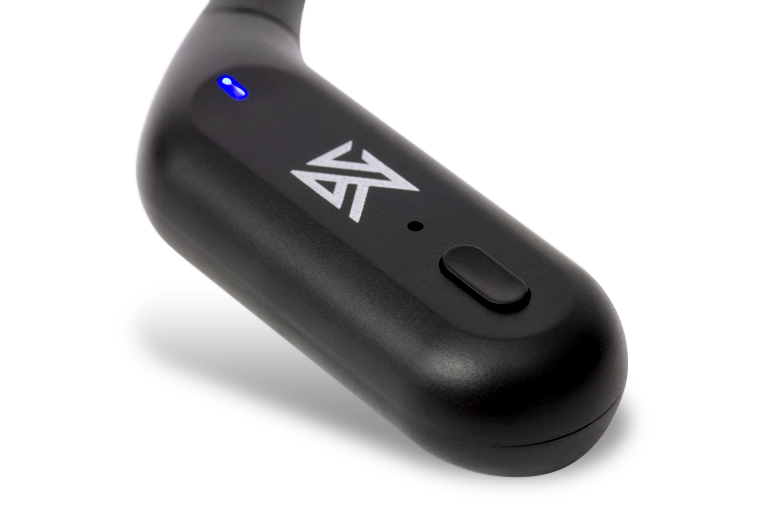
I pretty much had to buy the KZ AZ09s. Recently, I’ve been reviewing so-called “Chi-Fi” earphones—designs wearing Chinese brands that cost five to ten times less than comparable products from the big names in audio. (My most recent was the TinHiFi T3 Plus earphones.) All of those products have detachable cables, and I’d tell readers that they could pick up the KZ AZ09 adapters if they wanted to convert the earphones to true wireless. But I’d never actually tried the KZ AZ09 adapters, so I didn’t know how well—or even if—they worked. Considering that the early true wireless earphones were so unreliable, and that I still occasionally encounter models with frustrating connection problems, I realized that if I’m gonna say these earphones can be used with true wireless adapters, I’d better find one I can confidently recommend.
The KZ AZ09 package includes two adapter modules, one for the right ear, one for the left. You plug an adapter into each earphone, and the earphones should work like any standard true wireless earphones—except that there’ll be a receiver/battery module hanging behind your ear, kind of like many hearing aids. The modules include the standard SBC Bluetooth codec plus AAC.
The modules and the connected earphones fit into a sturdy metal charging case. Battery life is rated at six hours, and the charging case provides enough extra charges to get you up to a rated 42 hours of total use before you have to recharge the case. Admirably, KZ explains how they got those ratings—playing the Eagles’ “Hotel California” on repeat at 70% volume, using KZ EDX earphones.
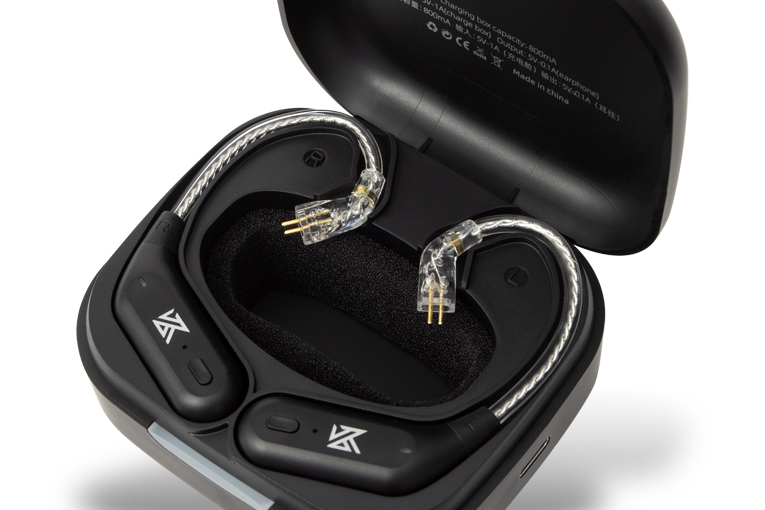
The two-pin cable connection used on most Chi-Fi earphones has two variants: the B-type, with uncovered pins on the source end, and the C-type, with pins that are protected by a plastic shroud. The TinHiFi T3 Plus earphones are my favorite among the Chi-Fi models I’ve reviewed so far, so I chose the B-type version of the KZ AZ09 adapters. If you buy this product, make sure you’re buying the right version for your earphones. The product page on Amazon lists several earphones that are compatible with each version.
KZ doesn’t provide any performance specs with the AZ09 adapters, but I was able to run some product measurements, which you can access from the measurements link at the top of this review.
In the box
You get the modules, the charging case, and a 6″ (15cm) USB-A-to-USB-C charging cable. You supply the earphones and the charger.
Use
I was somewhat expecting the modules to be fussy to attach to the earphones and pair with my phone, but I had no problems at all. I found the modules comfortable to wear on long walks and even on a four-hour plane trip; the T3 Plus earphones, as before, sealed securely and comfortably in my ears, and I barely noticed the modules hanging behind my ears. The only ergonomic downside is that the charging case is bulky at 1.4″ thick by 3.4″ square (3.5cm by 8.7cm by 8.7cm).
The AZ09 adapters are easier to use than most true wireless earphones because there’s only one small pushbutton on each module. However, the simplicity of the controls limits the functionality; while you can pause playback and skip to the next or previous track, there’s no way to adjust volume on the modules.
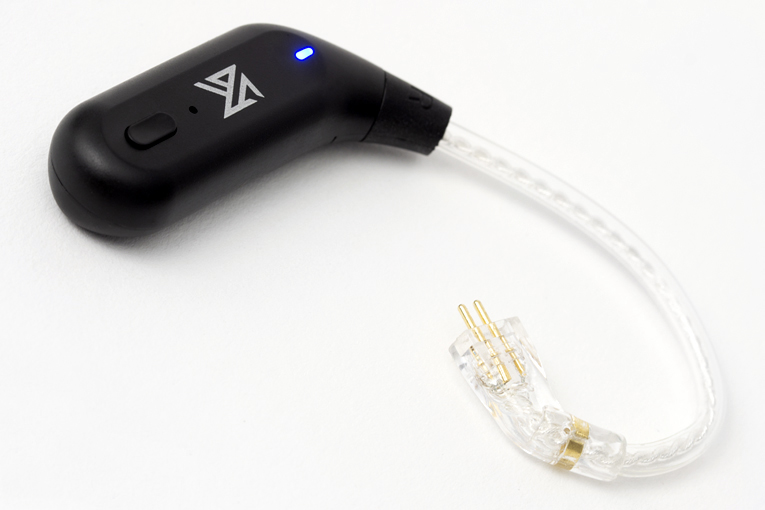
The Bluetooth connection was about as reliable as that of most true wireless earphones; I occasionally experienced a few dropouts when I put my phone in my pants pocket, but that happens with many, perhaps most, true wireless earphones.
The AZ09 adapters incorporate tiny microphones that allow you to take phone calls through the earphones. I made a few calls while wearing them, and everyone said the voice clarity seemed about typical for Bluetooth headphones—although these calls were all indoors. Many advanced (and usually, expensive) true wireless earphones incorporate multiple microphones per ear so they can cancel background noise and wind.
One little weirdness: the adapters add a voice announcement that tells you when the Bluetooth connects and disconnects, but it’s done by someone for whom English clearly wasn’t their first language. Thus, the announcements sound like “connectate” and “disconnectate.” I took this as a welcome touch of exotica rather than a flaw.
Sound
After I connected the T3 Pluses to the modules and started out on one of my daily dog walks, I quickly and happily realized that the modules didn’t seem to have any effect on the earphones’ sound. The T3 Pluses had the same balanced, clear, detailed sound I heard before; the only apparent difference was that I didn’t have a cable getting in my way.
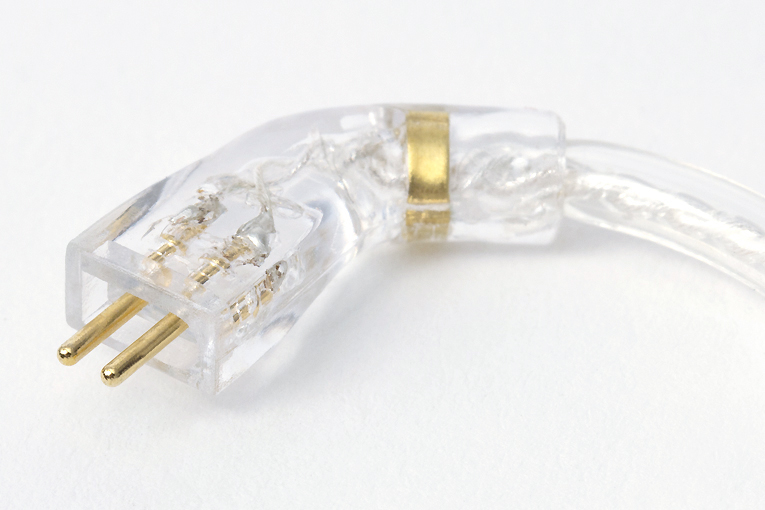
Although I was happy with the sound, and pretty thrilled with the AZ09/T3 Plus combo during my dog walks, airplane rides, and ventures on the New York subway, I figured I should do some more formal testing, so I cued up “Trouble Is a Man” from Patricia Barber’s Clique (16-bit/44.1kHz FLAC, Impex/Qobuz) and compared the sound with each AZ09 module cabled to my Samsung Galaxy S10 phone, and then with the AudioQuest DragonFly Cobalt DAC-headphone amp in the chain. The sound from the hardwired phone and from the Cobalt should have been better than what I heard from the AZ09 modules, because they use Bluetooth and have to go through a lossy compression/decompression cycle, while the others don’t.
But to my surprise, this wasn’t the case. All of the options sounded good, but I actually preferred the sound from the adapters, which had somewhat more robust bass and a smoother reproduction of Barber’s voice. The direct cable connection to the phone and the Cobalt DAC-amp both exhibited a little extra clarity in the cymbals (in my experience, the instrument that lossy codecs tend to degrade the most), but this advantage was more than outweighed by the added sibilance in Barber’s voice. It’s possible that the little bit of extra bass the AZ09 modules delivered had the psychoacoustic effect of softening the treble slightly, thus minimizing the sibilance. But regardless, I preferred the wireless fidelity with the AZ09 adapters to the theoretically superior sound of the direct connections.
Just to shift gears as far as I possibly could, I switched over to the CCA C10 earphones; each of the CCA C10s’ earpieces incorporates four balanced armatures plus a single dynamic driver for the bass, in comparison to just a single dynamic driver in each of the T3 Pluses’ earpieces. This should make for a bigger difference in the sound when switching from the adapters to the phone’s headphone amp to the Cobalt, because variances in the output impedances of the sources will interact more with the balanced armatures, which tend to exhibit large impedance swings.
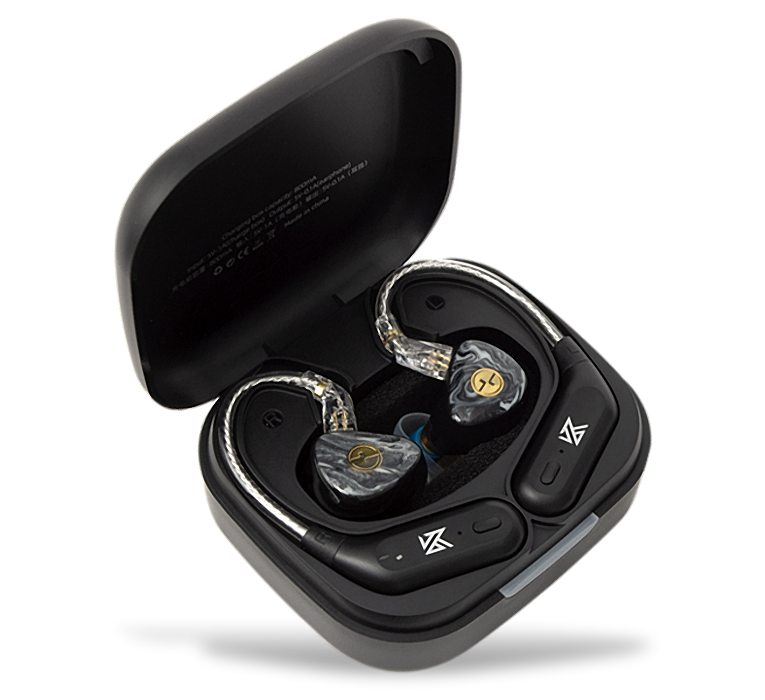
Playing Joni Mitchell’s “Big Yellow Taxi” (Ladies of the Canyon, 16/44.1 FLAC, Rhino/Qobuz) through the AZ09/C10 combo, I heard lots of detail—it was even easy to make out the subtle amount of reverb added to the vocal. However, the balance seemed a little on the trebly side—perhaps an interaction of the AZ09 adapter’s output impedance with the balanced armatures’ impedance. But this time, I preferred the sound with the C10s connected straight to the phone. It seemed slightly better in every way, with an added touch of clarity throughout the audio spectrum. As audiophiles often say, switching to the cabled connection was like lifting a veil from the sound—albeit a very thin veil. Switching to the Cobalt, I heard a similar, but much smaller, improvement even over the direct connection to the phone. Certain sounds, such as the tambourine during the verse, and the triangle during the chorus, were ever-so-subtly clearer with the Cobalt.
Comparison
I didn’t have any other true wireless adapters to compare with the AZ09 adapters, but I did have something that is similar from a technical standpoint: Anker’s Soundsync A3352 Bluetooth receiver ($32.99), which can be used as a Bluetooth receiver for a home or car stereo, and can also drive headphones directly. This comparison would be more fair, because both devices would have to rely on a Bluetooth connection to my phone.
Using the CCA C10s again (which I thought might amplify the differences in sound), listening to Nathaniel Rateliff’s “What a Drag” (And It’s Still Alright, 24/88.2 FLAC, Stax/Qobuz), I found the sound clear, spacious, and vivid when I used the AZ09s. The reverb went way deep, and the acoustic guitar and drums sounded especially lively. When I switched to the Soundsync A3352 receiver, the balance sounded bassier, which had the psychoacoustic effect of making the treble sound a little softer. Other than the mild tonal balance tilt, though, I couldn’t hear any difference. Whether you’d prefer the sound of the AZ09 adapters or the Soundsync A3352 depends on your personal taste, and will likely vary depending on the music you’re listening to.
Conclusion
I feel like I’ve discovered something of an audiophile holy grail with the AZ09 adapters. Pair them with the right set of earphones (like the TinHiFi T3 Pluses), and you can get outstanding sound quality for less than $100 total. You’ll also have a setup that’s easy to use (something many true wireless earphones can’t say) and comfortable (something many high-end audiophile earphones can’t say). And you’ll have your own bespoke creation that, like a carefully assembled audio system, will make your heart swell with pride every time you use it.
. . . Brent Butterworth
Associated Equipment
- Smartphone: Samsung Galaxy S10
- Earphones: TinHiFi T3 Plus, CCA C10
- DAC-amplifier: AudioQuest DragonFly Cobalt
- Bluetooth adapter: Anker Soundsync A3352
KZ AZ09 True Wireless Adapters
Price: $29.99.
Warranty: One year.
KZ Acoustics
2/F, Building A, No. 26 Hantang St.
Qiantou community, Doncheng St.
Dongguan City, China
Phone: (+86) 177-2238-3014
Website: www.kzhifi.com




